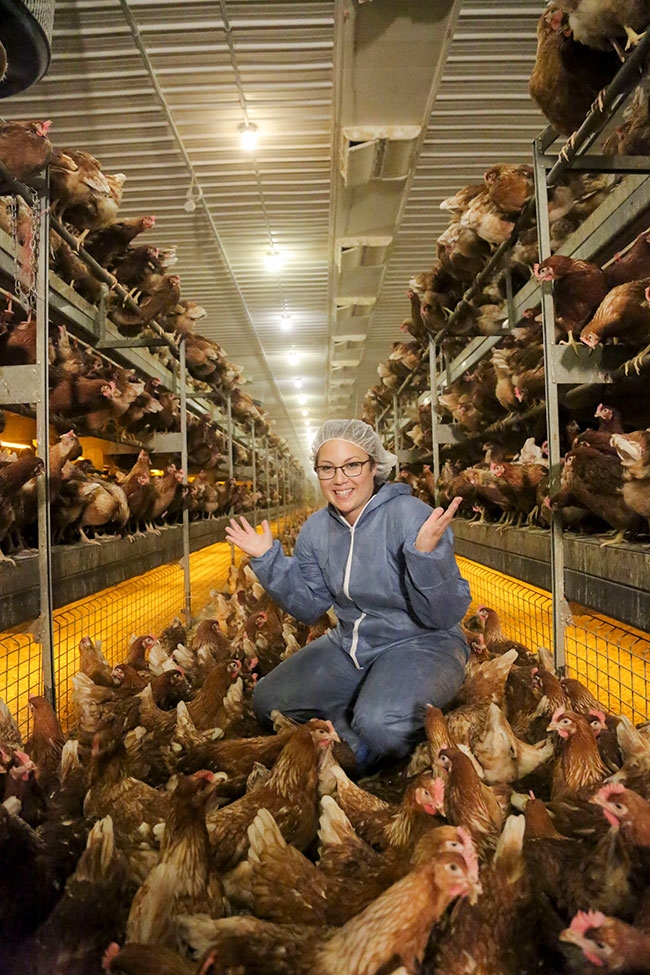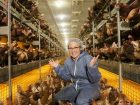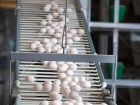
Maximizing eggshell quality
By Treena Hein
Features Layers Production annex Canada Egg production Nutrition ProductionSuccess requires a clear understanding of several interrelated factors.
 Dr. Kayla Price, Canadian poultry technical manager at Alltech Canada, says several interrelated issues affect eggshell quality. PHOTO CREDITS: Alltech
Dr. Kayla Price, Canadian poultry technical manager at Alltech Canada, says several interrelated issues affect eggshell quality. PHOTO CREDITS: AlltechAlthough it has improved over the years due to the availability of better genetics and better diets, eggshell quality remains a concern. “When you look at the Canadian market information tables for Canadian egg production in 2017 (from Egg Farmers of Canada), approximately seven per cent of all eggs were down-graded as either grade B, C, nest run or other reject eggs,” notes Dr. Kayla Price, Canadian poultry technical manager at Alltech Canada. “Eggs with cracks would make up a portion of these down-graded eggs.”
Of course, egg handling from farm to plate, nutrition and overall bird health are critical factors. That said, she adds there are other important interrelated issues affecting eggshell quality, including flock management, bird age, size of egg and gut health.
Price, who in her role with Alltech provides technical and sales support with additional research responsibilities, recently outlined these elements in a webinar titled “Egg-cellent shell quality: Learn the basics”. Canadian Poultry spoke with her for a closer look at each key success factor.
Flock management
Price notes that providing good quality water and access to such water are important to egg and shell quality simply because they support good layer health – and healthy birds lay good quality eggs. “Additionally, water can have different mineral or biological contents,” she explains, “that could also impact how well water lines can be cleaned, the flow of water, how well birds are vaccinated (if water line vaccination is used) and so on.”
Good air quality in the barn – mainly reduced environmental ammonia – is another important eggshell quality factor, as is ongoing enforcement of proper biosecurity measures.
“The producer ultimately wants to reduce stresses and possible disease challenges that the layer hen might face,” Price explains, “so that she can put her energy towards body maintenance and egg production.”
Bird age/egg size
We know that egg size is related to eggshell quality and the age of the hen. Price explains that once a hen reaches peak production, she produces a relatively consistent amount of eggshell material per egg and, thus, the amount of shell the hen can produce does not necessarily increase at the same rate as the egg size increases. As a result, at peak production onwards, if the hen produces a larger egg, the shell will be thinner compared to a smaller egg from the same hen.
Therefore, as hens age and production parameters change, Price notes that many dietary components change. This ranges from protein, amino acids and calories to calcium, phosphorus, vitamins and minerals.
In general, once the hen reaches her mature size (optimum egg size and peak egg production), she only needs enough nutrients to maintain this production. “If she gets more nutrients – especially certain amino acids – her egg size can increase beyond the desired size,” Price points out, “and more cracks can arise.”
However, calcium is the exception. Price says there is a need to provide increased levels of calcium as the hen ages so that the bird can provide calcium for her eggs in addition to her own body maintenance.
With regard to when smaller or larger particles of calcium should be provided, Price says that while poultry genetic companies will have different recommendations for the ratio to give during various phases of production, smaller particles are generally given during the initial phases.
In addition, she points out that, as described in Commercial Poultry Nutrition by Leeson and Summers, larger-particle calcium is thought to take longer to break down.
Therefore, it may be able to stay in the gizzard for a longer period of time and act as a store of calcium overnight. “As the bird ages, this extra store of calcium can help not only with the calcium in the egg, taking some of the onus from the medullary bone,” she says, “but also to help the quantity and activity of medullary bone.”
Price adds that hens can do a certain amount of selecting large-particle calcium according to their own needs, if given the opportunity to choose.
In addition to watching nutrient intake and grain particle size, Price says a well-planned diet program created in partnership with a nutritionist must also focus on avoiding grain mycotoxins and making sure bioavailability of minerals is high enough (e.g. using proteinated trace minerals). “Additionally, it is important to pay attention to the timing of when fresh feed is being added to encourage uniform consumption of the diet,” she notes. “Good communication between producers and their nutritionists and suppliers can help to understand this complex process.”
- Dr. Kayla Price, Canadian poultry technical manager at Alltech Canada, says several interrelated issues affect eggshell quality.
Gut health
The intestinal tract of the chicken features villi (and microvilli) – tiny bumps that increase its surface area and, therefore, boost chemical breakdown and absorption of nutrients. So, anything that damages the intestinal tract, even slightly, presents a potential negative impact on bird performance – including eggshell quality.
However, Price explains that a balanced and diverse microflora is also needed for good gut health. “We must remember that the intestinal tract contains more than just intestinal cells,” the researcher notes.
“It is also an ecosystem in which microbes and the intestinal environment should be in balance. The microbes can consist of different organisms but are mostly made up of bacteria and these can be beneficial or opportunistic (that is, they will become bad if the environment allows for it).”
Price notes that managing the gut health of the hen is a matter of employing a detailed and holistic approach to barn and bird management. This includes preventative management with effective biosecurity and consistent health measurements.
“This program would ideally be started in the pullet phase and used throughout production,” Price explains.
“This program would help to ensure the pullets and the layers are off to the right start and are getting the most from their feed while building immunity. The Seed Feed Weed program, as pioneered by Dr. Steve Collett (University of Georgia), is a critical part of this program,” she adds. (Read all about that program in the December 2017 issue of Canadian Poultry magazine.)
Conclusions
At the end of the day, Price encourages producers to continue their good work to provide the best management possible for their hens and pay attention to details related to eggshell quality. Additionally, she stresses the need for good communication between the egg producer, nutritionist and veterinarian.
“Producers need to have open communication with their nutritionists to frequently make note of egg size as well as keep a close eye on the hens for body weight before and during production,” Price says. “Producers also need to communicate well with their veterinarians to ensure a proper vaccination and health management program for prevention of other factors that could contribute to fragile eggs.”
Shell quality is affected by:
- Genetics
- Egg handling
- Flock management (water quality, reduced environmental ammonia, proper biosecurity measures)
- Bird age
- Egg size
- Gut health (keeping the intestinal tract intact and the microflora population balanced)
- Diet/nutrition
- Overall bird health
6 key takeaways:
- Once a hen reaches maturity, if she receives more nutrients than she needs to maintain optimum egg production – especially certain amino acids – her egg size can increase beyond the desired size. Larger eggs have thinner shells and are therefore more prone to cracking.
- Calcium must be increased as the hen ages.
- Calcium particle size can be increased as the flock ages.
- A well-planned ration program created in partnership with a nutritionist must also focus on avoiding grain mycotoxins, making sure mineral bioavailability is high and that provision of any fresh feed is timed properly.
- Price recommends the Seed Feed Weed gut health program, as pioneered by Dr. Steve Collett at the University of Georgia.
- Good communication between the producer, nutritionist and veterinarian is critical to minimize fragile eggs.
Print this page

